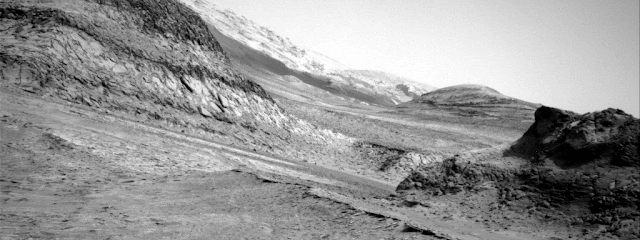 |
| IO |
Saturday, December 31, 2022
Animated GIFs to illustrate activity of Recurring Slope Lineae (RSL), described in the 5 August 2011 Science report “Seasonal Flows on Warm Martian Slopes”
Animated GIFs to illustrate activity of Recurring Slope Lineae (RSL), described in the 5 August 2011 Science report “Seasonal Flows on Warm Martian Slopes”.
All of these animated GIF files consist of a series of orthorectified HiRISE images over locations with RSL activity. Orthorectification corrects oblique images to show how the scene would appear from directly overhead. We perform this using HiRISE Digital Terrain Models (DTMs) at a scale of 1 m/posting. The orthorectified images are all at 0.25 m/pixel scale (or 0.5 m/pixel in cases noted below), so features smaller than 1-2 m diameter cannot be correctly rectified; the result is that small-scale features like boulders appear to wag back and forth.
Each GIF is timed to dwell 2 seconds on the first and last frames and 1 second on intermediate frames, but network or computer performance may cause this to vary. The legend on each image gives the exact HiRISE image identifier; see http://uahirise.org/{image identified} for more information about each image. The legend also marks the year and seasonal identifier (Ls) for each image. The Mars years begin with the first years of Mars exploration by robot spacecraft. Ls stands for areocentric longitude of the sun, dividing the year into 360 degrees to mark the seasons. Ls = 180 is the beginning of southern spring, Ls = 270 is the beginning of southern summer, and Ls = 360 (or 0) is the beginning of southern autumn.
Well-preserved crater on floor of Newton Crater
Each of the gifs below are enhanced color sequences from different section of this crater slope, starting with faded RSL in MY29 (except one in which the color data was largely missing), then showing a sequence of RSL forming and fading in MY30. RSL activity in MY28 was also seen (PSP_005943_1380), but the color coverage does not overlap the later images. These images were also used in the video produced by JPL.
Newton_IRB_A.ORth-enh-crop1_leg.gif
Newton_IRB_A.ORTHO-stretch-enh-crop2_leg.gif
Newton_IRB_A.ORTHO-stretch-enh-crop3_leg.gif
Newton_IRB_A.ORTHO-stretch-enh-crop4_leg.gif
Newton_IRB_A.ORTHO-stretch-enh-crop5_leg.gif
Steep crater slope in Terra Cimmeria
B&W sequence with 8 time steps, including all 3 southern summers covered by MRO showing RSL activity in each year. The last 5 frames are all from the most recent (MY30).
Steep_slope-RED-crop1_leg.gif
Steep_slope_IRB-crop2_leg.gif
Sequence of enhanced color images, starting in summer of MY28, then 4 frames from MY30.
Central structures in Horowitz Crater
Horowitz_RED_A_O-crop1-2x_leg.gif
This B&W sequence starts with the prominent RSL seen in MY28, then shows a sequence from MY30 with much less extensive RSL activity. Resolution reduced to 0.5 m/pixel. Of particular interest here are the many detached RSL on the lower slopes, perhaps due to flows that are sometimes entirely below the surface. Some of the Horowitz images were highly oblique, leading to highly foreshortened of even hidden surfaces that can?t be recreated by orthorectification, instead forming smeared-looking areas where there was a great deal of interpolation.
Horowitz_RED_A_O-crop1B_leg.gif
Part of area seen in the gif above, but at full resolution (0.25 m/pixel).
Horowitz_RED_A_O-crop2-2x_leg.gif
Hill in the region of the Horowitz central uplift, where there was dense coverage by RSL in MY28 (first image) and much sparser activity in MY30. (There was no coverage in MY29.) Also of interest here is the bright streak at lower left, that was not present in MY28, but showed no further changes in the warm seasons of MY30. This behavior is like that seen at other active gullies, which change during the coldest times of year when there is CO2 frost on the ground. Reduced to 0.5 m/pixel scale.
Horowitz_RED_A_O-crop3_leg.gif
Region of Horowitz central uplifts with dense RSL in MY28 (first image), and significant activity in MY30. Note again the detached RSL here, and how they grow and fade over time in MY30.
Horowitz_IRB_A.ORTHO-cropA_leg.gif
Color sequence, om east-facing slope with dramatically changing shadows as a function of season.
Horowitz_IRB_A.ORTHO-cropB-alt_leg.gif
Another color sequence in Horowitz crater. This one shows how the RSL follow small channels. Maybe RSL activity can carve such channels over many years, or maybe the channels were created by a different process. No topographic changes associated with RSL has been detected.
Fresh-crater-1315
Fresh_crater_IRB_A.ORTHO-RSL-crop2-str2_leg.gif
Enhanced color sequence is a well-preserved impact crater about 4 km in diameter. The first image is from MY29, with others from MY30. In this location the RSL are a bit more active in MY30 than in MY29.
Fresh_crater_RED_A_O-RSLcrop_leg.gif
A sequence in this crater where color coverage is absent or incomplete. All images from MY30.
Credit: NASA/JPL/University of Arizona
















































